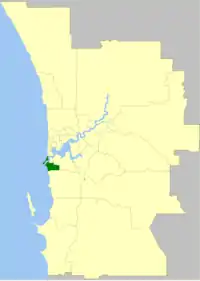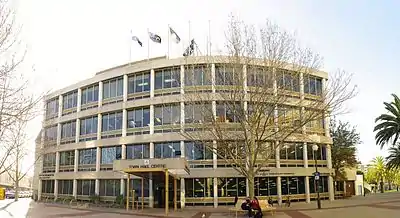City of Fremantle
The City of Fremantle is a local government area in the south of Perth, Western Australia. The City covers an area of 19.0 square kilometres (7.3 sq mi), and lies about 19 kilometres (12 mi) southwest of the Perth central business district.
| City of Fremantle Western Australia | |||||||||||||||
|---|---|---|---|---|---|---|---|---|---|---|---|---|---|---|---|
 | |||||||||||||||
| Population |
| ||||||||||||||
| • Density | 1,521/km2 (3,939/sq mi) | ||||||||||||||
| Established | 1871 | ||||||||||||||
| Area | 19.0 km2 (7.3 sq mi) | ||||||||||||||
| Mayor | Brad Pettitt | ||||||||||||||
| Council seat | Fremantle | ||||||||||||||
| Region | Southern Metropolitan Perth | ||||||||||||||
| State electorate(s) | Fremantle, Willagee, Cottesloe | ||||||||||||||
| Federal Division(s) | Fremantle | ||||||||||||||
 | |||||||||||||||
| Website | City of Fremantle | ||||||||||||||
| |||||||||||||||
History
In 1848 a town trust was formed comprising a chairman and a committee of five. For the next twenty-three years they set about constructing roads and many public buildings with the use of convict labour. By 1870 the population of Fremantle had reached 3,796 and it was a moderately flourishing town, resulting in a move among the colonists to secure greater control of the management of their affairs.
The Municipality of Fremantle was formed on 21 February 1871, with the new council having a chairman and nine councillors.[3] Two of the major achievements of the town council were a reliable supply of pure water and a more efficient system of sanitation. By 1928 Fremantle had a population of 22,340 and an annual revenue of £73,354 - enough to warrant a claim for city status. The City of Fremantle assumed its current name when city status was conferred upon Fremantle on 3 June 1929 as a Centenary of Western Australia honour.[4][5]
North Fremantle, originally part of Fremantle, broke away in October 1895 to become an independent municipality. The first mayor of North Fremantle was Daniel Keen Congdon.[6] The two municipalities were reunited by an order of the Governor in Executive Council as from 1 November 1961.[7]
Wards
The City is divided into six wards, each electing two councillors. Each councillor serves a four-year term, and half-elections are held every two years. The mayor is directly elected.
- North Ward
- Hilton Ward
- South Ward
- Beaconsfield Ward
- City Ward
- East Ward
Mayors of Fremantle
Suburbs
East Fremantle has its own town council and is not governed by the City of Fremantle.
Population

|
|
- The 1961 population of the former Town of North Fremantle was 2,363.
Economy
The economy of the city is highly stable and diversified with various local businesses trading successfully in the vicinity. The key industries include port and shipping, regional and state government services, hospital and community services, tourism, education, retail, etc. In 2014, over 4,472 registered businesses were operating in the city and the size of the workforce in the city centre had reached 8,849 in 2011.[8]
Sister city relations
Fremantle has sister city relationships with five other cities.[9] They are (in chronological order):
 Seberang Perai, Malaysia (since 1978)
Seberang Perai, Malaysia (since 1978) Yokosuka, Japan (since 1979)
Yokosuka, Japan (since 1979) Capo d'Orlando, Italy (since 1983)
Capo d'Orlando, Italy (since 1983) Molfetta, Italy (since 1984)
Molfetta, Italy (since 1984) Funchal, Portugal (since 1996)
Funchal, Portugal (since 1996)
Fremantle also has friendship-city relationships with three cities:
See also
References
- Australian Bureau of Statistics (27 June 2017). "Fremantle (C)". 2016 Census QuickStats. Retrieved 26 November 2017.

- "3218.0 – Regional Population Growth, Australia, 2017-18". Australian Bureau of Statistics. 27 March 2019. Retrieved 31 December 2019. Estimated resident population (ERP) at 30 June 2018.
- "Municipality Boundary Amendments Register" (PDF). Western Australian Electoral Distribution Commission. Retrieved 11 January 2020.
- "FREMANTLE A CITY". The Daily News (Perth, WA : 1882 - 1950). Perth, WA: National Library of Australia. 1 June 1929. p. 4 Edition: FINAL SPORTING EDITION. Retrieved 22 August 2013.
- How the council developed 1829-1972. (1972). In Gateway, Vol. 1, No. 1 June 1972, pp. 30-31.
- W. B. Kimberly, ed. (1897). History of West Australia. p. 24.
- Ewers, J.K. (1971). The Western Gateway: a history of Fremantle, 2nd Ed. p.179.
- "Economy". City of Fremantle.
- "Sister cities and international relations". City of Fremantle website. Archived from the original on 15 October 2012. Retrieved 22 May 2011.

